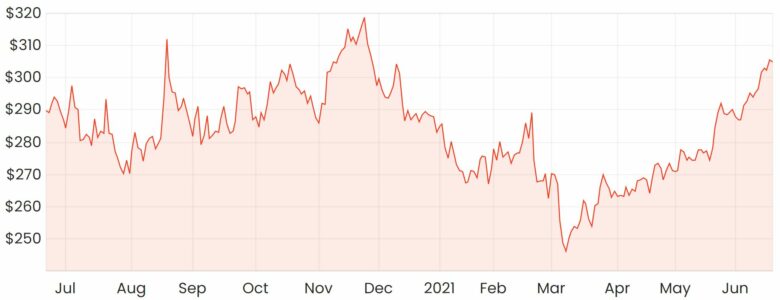Shares in healthcare giant CSL Limited (ASX: CSL) have made a strong recovery recently.
Since reaching lows of $242 in March, shares have gained over 26% despite no announcements that were obvious catalysts behind the rally.
CSL share price

What’s behind the rise in CSL shares?
One of the reasons why CSL struggled last year was due to the Australian dollar strengthening against the USD.
CSL generates less than 10% of its revenue here in Australia, while over 50% comes from the US. This acts as a headwind on revenue and profitability when our domestic currency is appreciating.
Other healthcare companies that face similar challenges are Resmed Inc (ASX: RMD), Cochlear Limited (ASX: COH) and Sonic Healthcare Limited (ASX: SHL).
The recent strengthening of the US greenback against the AUD could partly explain why CSL’s shares have seen a recovery in the past months.
Recent financial results
CSL last updated the market in February with its half-year results.
Despite It still experiencing lower than normal plasma collection volumes, CSL Seqirus – its influenza business, had actually been boosted by the Coronavirus pandemic.
Revenue in the segment had surged 38% for the six months to December 2020 to US1.4 billion. This helped CSL achieve a net profit after tax (NPAT) of US$1.8 billion, up 44% on H1 FY20.
Management is positive on the outlook for the company, saying that plasma collections will gradually improve as the global COVID-19 vaccine rollout continues.
What’s to like about CSL?
CSL has proved itself to be an exceptionally well-managed company and I tend to agree with management’s outlook for the company moving forward.
CSL’s scale benefits, solid balance sheet and competitive position will likely sustain it even during times such as these where collection volumes are lower than normal. At this stage, I believe these complications to be transitory in nature, so the investment case for CSL seems to still be intact.
With a forward Price/Earnings (P/E explained) ratio of around 60, CSL’s shares don’t appear to come cheap – but this might not be the best way of assessing their value.
Rather than spreading out research and development costs over a number of years, CSL expenses all these costs as incurred in the first year.
In comparison to spreading out costs (capitalising), expensing costs will have a suppressive effect on net income and will therefore inflate its P/E ratio.
It’s important to note that CSL relies on investing nearly a billion a year into R&D which will drive future growth. So, while R&D spending gives the impression of an expensive stock, I think that valuing CSL on a P/E basis is far less meaningful than some might think.
What’s more important would be assessing its R&D pipeline to identify what could provide the company with further growth opportunities.
If you’re looking to become a better investor, I’d recommend getting a free Rask account and accessing our full stock reports. Click this link to join for free and access our analyst reports.








